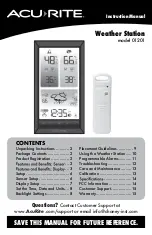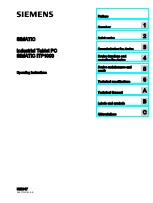
La Crosse Technology, Ltd.
Page 11
When alarm 1 or alarm 2 sounds, press the SNOOZE/LIGHT button once to activate the snooze
feature for 10 minutes.
The alarm icon and the snooze icon
Zz
will flash when the snooze is active.
Press any button to deactivate the snooze feature.
Forecast Icons Inaccurate
Weather Forecast Icons:
(Sun, Slightly Cloudy, Cloudy, Rainy, or Snow).
These icons forecast the weather in the next 12-24 hours. The forecast icons displayed, predict the
weather in terms of getting better or worse and not necessarily sunny or rainy as each icon indicates.
Note:
After set up, disregard readings for weather forecasts for the next 48-60 hours. This will allow
sufficient time for the forecast station to collect air pressure data at a constant altitude and therefore
result in a more accurate forecast.
Forecast Arrows
WEATHER TENDENCY INDICATOR (Up or Down arrows):
Working together with the weather icons is the Weather Tendency Indicators. When the Indicator
Points Upwards, it means that the Air-pressure is increasing and the weather is expected to improve,
but when Indicator Points Downwards, the Air-pressure is falling and the weather is expected to
become worse.
Clothing Index
Fisherman:
The Fisherman Clothing Icon combinations display based on Outdoor Temperature from
the transmitter on
channel 1 only
. The Fisherman represents CURRENT TRENDS in Temperature.
Absolute Barometric Pressure
The forecast station reads Barometric Pressure.
The numeric pressure value adjusts automatically as the forecast station reads changes in air
pressure.
Since this number is
absolute
pressure it may not be the same as a local reporting Station that reads
in
relative
pressure.
Note:
The pressure number
cannot
be calibrated.
Absolute Pressure
is measured in a vacuum without the influences of terrain, weather, water, foliage
and elevation. The air pressure it would be consistent at every elevation and decrease as it went
higher.
Relative Pressure
is a combination of air pressure and altitude. Relative air pressure will make
readings in local areas relative to each other to allow for proper forecasting.
Absolute Pressure Unit of Measure
Hold the HISTORY button for 5 seconds to switch from InHg (inches or mercury) or hPa (Hectopascal) for
the numeric pressure display and the pressure graph.
Inches of Mercury
is common for weather reports and aviation in the United States.
Hectopascal
is equivalent to millibar and commonly used to measure atmospheric pressure outside
the United States.
Pressure History
Numeric History:
Press and release the HISTORY button to view the past 12-hours of numeric pressure history.
In the small box to the right of the numeric pressure a number from 0 to -12 will appear.
0 is current pressure. -1 through -12 reflects the history in one-hour increments.
Note:
The history graph and forecast icons will not change when you view pressure history.
12-hour Pressure History Graph































